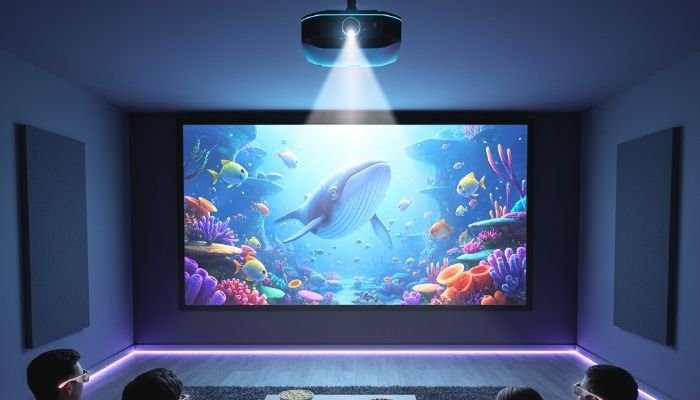In today’s bustling world of home entertainment, 3D home cinema solutions offer a captivating way to escape into your favorite stories without stepping foot outside. As we hit October 2025, these systems have evolved far beyond their early days, blending seamless technology with everyday comfort to create experiences that feel truly personal and immersive. If you’ve ever Googled “best 3D home theater setups” or pondered “how to build a 3D home cinema on a budget,” this guide is your all-in-one resource. We’ll cover the latest 3D home cinema trends, key components, step-by-step installation advice, and forward-thinking innovations—all tailored to turn your living room into a sanctuary of cinematic wonder. Whether you’re upgrading for family game nights or solo binges, discover how 3D home theater systems can redefine relaxation right at home.
The Basics and Benefits 3D Home Cinema Solutions
3D home cinema solutions leverage stereoscopic imaging to deliver two parallel images—one for each eye—that your brain fuses into a single, three-dimensional view. This creates depth and movement that flat screens simply can’t match, making everything from explosive action sequences to tranquil landscapes feel alive and enveloping. In essence, it’s like adding a new layer to your viewing: objects extend toward you, backgrounds recede into infinity, and the overall immersion skyrockets.
Why invest in a 3D home theater system now? For starters, 2025 marks a sweet spot where technology meets accessibility. With rising interest in hybrid home spaces—where living rooms double as offices or play areas—these setups provide versatile entertainment that adapts to your lifestyle. Benefits include heightened emotional engagement (think heart-pounding thrills during a chase scene), enhanced family bonding through shared awe, and even practical perks like better focus for educational content or gaming. Plus, in an era of endless streaming, 3D home cinema solutions cut through the noise, offering premium quality that streaming services are increasingly supporting with dedicated formats.
Common questions like “are 3D home theaters worth it?” often boil down to personal taste. If you crave that extra dimension for select content, the answer is a resounding yes. And with modular designs, starting small and scaling up is easier than ever, ensuring your investment grows with you.
Top 3D Home Cinema Trends Shaping 2025
The home cinema trends 2025 scene is buzzing with innovations that make 3D home theater systems more intuitive and impactful. Here’s what’s driving the excitement this fall:
1. Smart Integration for Effortless Control
Modern 3D home cinema solutions now weave into your smart home ecosystem like never before. Voice-activated commands can trigger 3D modes, adjust lighting, or queue up content, turning setup into a hands-free affair. This trend responds to the growing demand for “smart home theater integration,” where systems learn your habits—dimming lights automatically at sunset or optimizing audio for movie time—making daily use feel magical rather than manual.
2. Brighter, More Versatile Displays
Brightness has been a 3D Achilles’ heel, but 2025’s best 3D projectors for home flip the script with laser technology that delivers vivid images in any lighting. Short-throw projectors, which cast large screens from close range, are particularly hot for urban dwellers with limited space. These advancements address searches like “3D projector for bright rooms,” ensuring your setup shines whether it’s a sunny afternoon or cozy evening.
3. Layered Audio Experiences
Sound in 3D home cinema setups isn’t just heard—it’s felt. Trends lean toward object-based audio, where sounds move dynamically around and above you, syncing perfectly with visual depth. Wireless multi-channel systems reduce clutter while maintaining punch, ideal for open-plan homes where echoes can muddy the mood.
4. Expanding Content Ecosystems
While 3D content availability has historically been spotty, 2025 sees a revival. Streaming platforms are rolling out more native 3D titles, from reimagined blockbusters to original series, alongside tools that convert standard videos into stereoscopic views. This ties into “3D streaming home theater” queries, making high-quality experiences more accessible without relying solely on physical media.
5. Eco-Friendly and Customizable Builds
Sustainability is key, with energy-efficient components and modular accessories allowing eco-conscious tweaks. Think recyclable glasses frames or upgradable projectors that evolve with tech—perfect for long-term searches like “sustainable 3D home cinema ideas.”
These 3D home cinema trends aren’t fleeting; they’re building toward a future where immersion is standard. By aligning your setup with them, you’ll future-proof your entertainment haven.
Key Components of a High-Performance 3D Home Theater System
Building a robust 3D home cinema setup requires thoughtful selection of parts that prioritize compatibility and quality. Focus on these essentials to answer “what do I need for a 3D home theater?”:
Displays: The Foundation of Depth
The heart of any 3D home cinema solution is a display that handles stereoscopy without compromise. 3D-capable TVs with organic light-emitting diode technology offer perfect blacks and wide viewing angles, while laser projectors excel in scale and brightness. Look for features like high refresh rates (120Hz or above) to eliminate motion blur and low crosstalk for sharp, ghost-free images. For versatility, choose models supporting both active and Passive 3D Projection—active for precision in dark rooms, passive for lighter, more comfortable group viewings.
In debates over “projector vs TV for 3D home cinema,” projectors win for grandeur, TVs for convenience. Pair either with a specialized screen to enhance contrast and reject stray light.
Sources: Unlocking Your 3D Library
Fuel your system with reliable sources that deliver uncompressed 3D signals. Universal media players excel at disc playback, capturing the full nuance of stereoscopic encodes. Gaming consoles add native 3D output for interactive titles, turning your setup into a play-and-watch powerhouse. For streaming, opt for devices with apps that handle 3D formats or upscale capabilities, addressing “best sources for 3D content at home.”
Organize with a central hub to catalog files, ensuring quick access to your growing collection.
Audio Systems: Completing the Sensory Puzzle
Dolby Atmos home theater systems elevate 3D visuals by mapping sound in three dimensions—overhead effects like helicopter rotors or echoing footsteps add tangible realism. Entry-level soundbars with height-firing drivers offer a simple start, while full surround arrays (5.1.4 or higher) deliver theater-level envelopment. Calibration software is crucial here, scanning your room to balance levels and tame reflections for optimal clarity.
Accessories: Enhancing Usability and Comfort
Round out your kit with wireless glasses for untethered viewing, certified cables for stable signals, and acoustic treatments to refine sound. Smart lighting kits automate ambiance, making 3D home cinema installation a breeze even in multifunctional spaces.
| Component | Key Features for 3D | Best For |
|---|---|---|
| Displays | High lumens, low crosstalk | Immersive depth in any light |
| Sources | 3D passthrough, streaming apps | Endless content access |
| Audio | Height channels, wireless surrounds | Multi-dimensional soundscapes |
| Accessories | RF sync, calibration tools | Seamless, hassle-free operation |
How to Set Up Your 3D Home Cinema System
Tackling “how to install a 3D home theater” doesn’t have to overwhelm. This Steps approach suits a standard living room, emphasizing simplicity and scalability.
Step 1: Design and Prep
Map your space: Calculate projector throw using free online tools and position furniture for optimal sightlines (seats 8-12 feet from the screen). Add blackout curtains and wall diffusers to control light and sound, creating a dedicated zone without full renovation.
Step 2: Assemble the Display and Sources
Secure your TV on a stand or projector via ceiling mount for stability. Connect sources with high-bandwidth cables, enabling 3D output. Test basic functionality—play a sample clip to confirm depth rendering.
Step 3: Layer in Audio
Place speakers strategically: mains at ear height, surrounds offset at 110 degrees, and heights flush-mounted. Run the system’s auto-calibration to profile your acoustics, then fine-tune volumes for balanced immersion.
Step 4: Add Accessories and Calibrate
Distribute glasses and sync them wirelessly. Use built-in tools or apps to align 3D images, minimizing any visual artifacts. Introduce smart controls for one-tap activation.
Step 5: Launch and Refine
Debut with a 3D showcase—adjust based on feedback, like boosting brightness for comfort. Regular maintenance, such as firmware updates, keeps things sharp.
Avoid pitfalls like uneven seating (aim for a 30-degree spread) or overlooked ventilation (projectors run warm). With this roadmap, your 3D home cinema setup goes live in a weekend, evolving as needed.
3D Home Theater Right for Your Lifestyle?
Every tech choice has trade-offs, so let’s evaluate 3D home cinema solutions honestly to guide “3D vs traditional home theater” decisions.
Advantages:
- Deeper Engagement: Stereoscopic depth amplifies emotions, making content more memorable.
- Multi-Functional Appeal: Boosts gaming responsiveness and educational tools with spatial accuracy.
- Scalable Investment: Modular elements allow gradual enhancements without waste.
Challenges:
- Selective Content: While expanding, 3D libraries require curation—great for enthusiasts, less so for casuals.
- Comfort Considerations: Prolonged use may tire some viewers; high-quality gear mitigates this.
- Learning Curve: Initial calibration takes time, but apps streamline it over iterations.
| Comparison Factor | Standard 2D System | 3D Home Cinema Solution |
|---|---|---|
| Visual Depth | Layered but Flat | Expansive and Interactive |
| Content Access | Broad and Instant | Targeted but Transformative |
| Installation Time | Quick Setup | Thoughtful Tuning |
| Daily Versatility | All-Purpose Ease | Premium Event Focus |
| Long-Term Value | Steady Reliability | Adaptive Innovation |
Ultimately, 3D home theater systems thrive for those seeking standout moments, complementing 2D for routine viewing.
Future Innovations in 3D Home Cinema
The horizon for 3D home cinema trends sparkles with promise. Glasses-free tech, using advanced lenticular displays, could eliminate headgear by rendering depth from multiple angles—imagine seamless holograms in your space. AI enhancements will personalize effects, like auto-adjusting convergence based on viewer distance.
Content pipelines will swell with 8K 3D streams and AR hybrids, blending real and virtual for interactive storytelling. Eco-innovations, such as low-power lasers and biodegradable materials, align with global shifts toward green tech. By decade’s end, 3D home theater systems may integrate with metaverses, extending immersion beyond screens into shared virtual realms.
Stay proactive: Choose expandable gear now to ride these waves effortlessly.
The Future of Home Entertainment with 3D Home Cinema
3D home cinema solutions represent more than gadgets—they’re a gateway to enriched living, where your living room becomes a stage for endless adventures. From navigating latest 3D home cinema trends to mastering a flawless setup, this guide empowers you to craft a space that delights. Whether chasing “affordable 3D home theater ideas” or premium polish, begin with essentials and let passion guide expansions.
Ignite your transformation today—what 3D title will christen your private theater? Drop your thoughts below, and check our guides on “surround sound optimization” or “smart home AV basics” for deeper dives. Your cinematic era starts now.



0 Comments on “ Transform Your Living Room into a 3D Home Cinema in 2025”